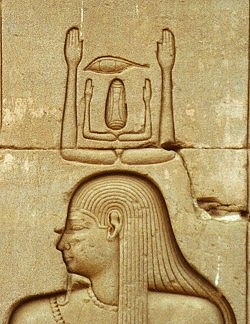
Das unübersetzbare Wort Ka verwendeten die Ägypter zur Bezeichnung jenes Aspektes von Menschen und Göttern, der mit der schöpferischen Lebenskraft verbunden ist. Der Ka ist jener Aspekt, der die lebende Person vom Toten unterscheidet. Der Ka enstand im Moment der Geburt und war eine Art Doppelgänger des Individuums. Manchmal wurde der Ka sogar als etwas kleinere Figur neben der lebenden Person dargestellt. Der Gott Chnum wurde gelegentlich an einer Töpferscheibe sitzend abgebildet, an der er sowohl den physischen Körper des Menschen als auch seinen Ka formte.
Wenn jemand starb, existierte der Ka weiter (und folglich auch die Person, weil der Körper lediglich der sichtbare Ausdruck der Ka-Kraft war) und mußte weiterhin ernährt werden. Daher wurde der Ka mit Opfergaben versorgt, die an der Scheintür im Grab dargebracht wurden, oder durch die Darstellung von Nahrungsmitteln an den Grabwänden. Der Ka sollte an der lebenspenden Kraft teilhaben, die ihnen innewohnte. In Anerkennung dieser lebenspendenden Kraft pflegten die Ägypter bei Mahlzeiten 'Für deinen Ka' zu sagen.
Grabstatuen galten als Statuen des Ka des Verstorbenen; manchmal trugen sie ein Ka-Symbol, wie es bei der Statue des Hor der Fall ist. Der Ka wurde als ein offenes, nach oben gerichtetes Armpaar dargestellt. Diese Arme symbolisierten die Weitergabe der Ka-Kraft von Vater zu Sohn, von Gott zu Mensch, von König zu Mensch. Diese Weitergabe kommt auch in Personennamen zum Ausdruck, die die Kontinuität des Ka über verschiedene Generationen hinweg betonten, beispielsweise 'Mein Ka wiederholt sich'. Wenn ein Ka von Gott zu Gott oder von Gott zu Mensch weitergegeben wurde, war damit die 'Einwohnung' einer göttlichen Macht in einen anderen Gott oder Menschen gemeint. Manchmal wird auf mehrere Kas Bezug genommen; der Schöpfergott und der König konnten mehrfache Kas besitzen, aber auch einfache Leute. Die Namen, die die Kas des Re in der Spätzeit erhielten, weisen darauf hin, daß das Prinzip der mehrfachen Kas nicht lediglich eine Vervielfachung der Macht bedeutete, sondern als eine Aufsplitterung der Ka-Kraft in verschiedene Aspekte wie Pracht, Ruhm, Lebenszeit, Macht, Nahrung, Sehen, Hören , Wissen aufgefaßt wurde. Diese Aspekte wurden voneinander unabhängig gemacht und als unzerstörbare Prinzipien des Lebens an sich begriffen, die nicht an das Leben eines Individuums gebunden waren.